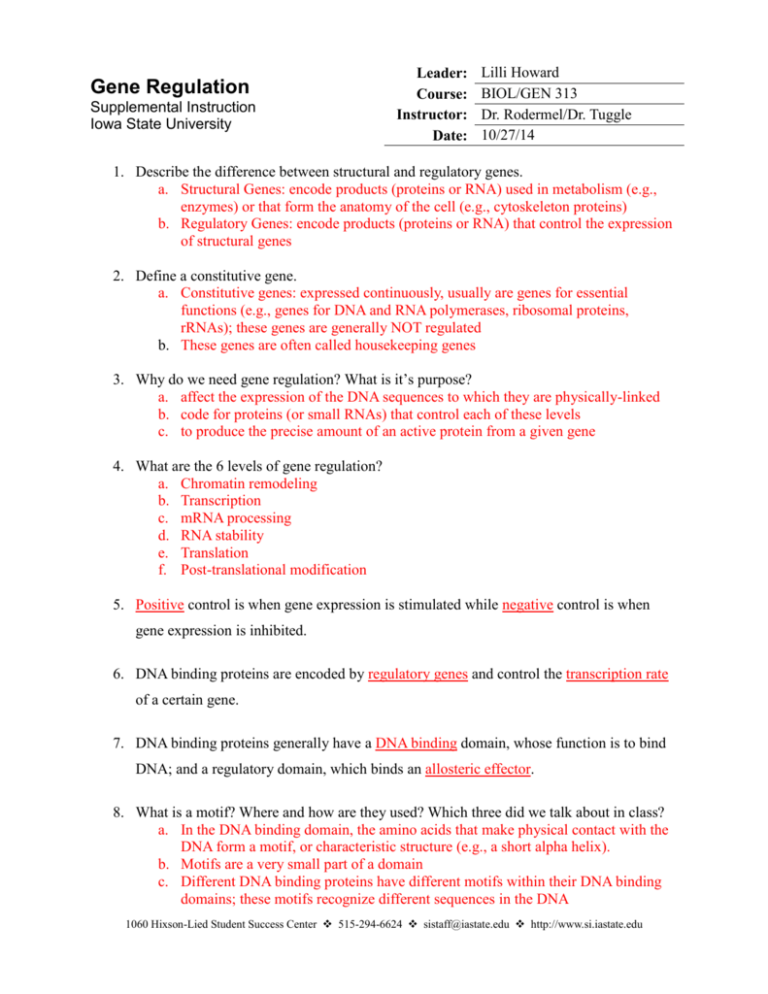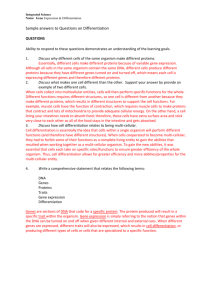10.27.14 KEY - Iowa State University
advertisement

Gene Regulation Supplemental Instruction Iowa State University Leader: Course: Instructor: Date: Lilli Howard BIOL/GEN 313 Dr. Rodermel/Dr. Tuggle 10/27/14 1. Describe the difference between structural and regulatory genes. a. Structural Genes: encode products (proteins or RNA) used in metabolism (e.g., enzymes) or that form the anatomy of the cell (e.g., cytoskeleton proteins) b. Regulatory Genes: encode products (proteins or RNA) that control the expression of structural genes 2. Define a constitutive gene. a. Constitutive genes: expressed continuously, usually are genes for essential functions (e.g., genes for DNA and RNA polymerases, ribosomal proteins, rRNAs); these genes are generally NOT regulated b. These genes are often called housekeeping genes 3. Why do we need gene regulation? What is it’s purpose? a. affect the expression of the DNA sequences to which they are physically-linked b. code for proteins (or small RNAs) that control each of these levels c. to produce the precise amount of an active protein from a given gene 4. What are the 6 levels of gene regulation? a. Chromatin remodeling b. Transcription c. mRNA processing d. RNA stability e. Translation f. Post-translational modification 5. Positive control is when gene expression is stimulated while negative control is when gene expression is inhibited. 6. DNA binding proteins are encoded by regulatory genes and control the transcription rate of a certain gene. 7. DNA binding proteins generally have a DNA binding domain, whose function is to bind DNA; and a regulatory domain, which binds an allosteric effector. 8. What is a motif? Where and how are they used? Which three did we talk about in class? a. In the DNA binding domain, the amino acids that make physical contact with the DNA form a motif, or characteristic structure (e.g., a short alpha helix). b. Motifs are a very small part of a domain c. Different DNA binding proteins have different motifs within their DNA binding domains; these motifs recognize different sequences in the DNA 1060 Hixson-Lied Student Success Center 515-294-6624 sistaff@iastate.edu http://www.si.iastate.edu d. Motifs bind sequences in the major groove e. They bind dynamically (come on and off– not covalent) to nucleotides by forming hydrogen bonds with bases or by electrostatic interactions with the DNA backbone 9. T/F: Genes in an operon are not necessarily related functionally. 10. T/F: A promoter is required for each gene in a operon 11. T/F: The regulator gene is part of the operon 12. How do amino acids in DNA-binding proteins interact with DNA? a. By forming covalent bonds with DNA bases b. By forming hydrogen bonds with DNA bases c. By forming covalent bonds with DNA sugars 13. For each of the following say if the statement is true or false. a. F: Structural genes are transcribed into mRNA, but regulator genes aren’t. b. F: Structural genes have complex structures; regulator genes have simple structures. c. F: Structural genes encode proteins that function in the structure of the cell; regulatory genes carry out metabolic reactions. d. T: Structural genes encode proteins; regulator genes control the transcription of structural genes. 14. What is the difference between positive and negative control? What is the difference between inducible and repressible operons? Positive control: gene expression is stimulated Negative control: gene expression is inhibited Inducible: expression is usually off (gene is inactive) Repressible: expression is usually on (gene is active) 15. In a negative repressible operon, the regulator protein is synthesized as: a. An active activator b. An inactive activator c. An active repressor d. An inactive repressor 1060 Hixson-Lied Student Success Center 515-294-6624 sistaff@iastate.edu http://www.si.iastate.edu








